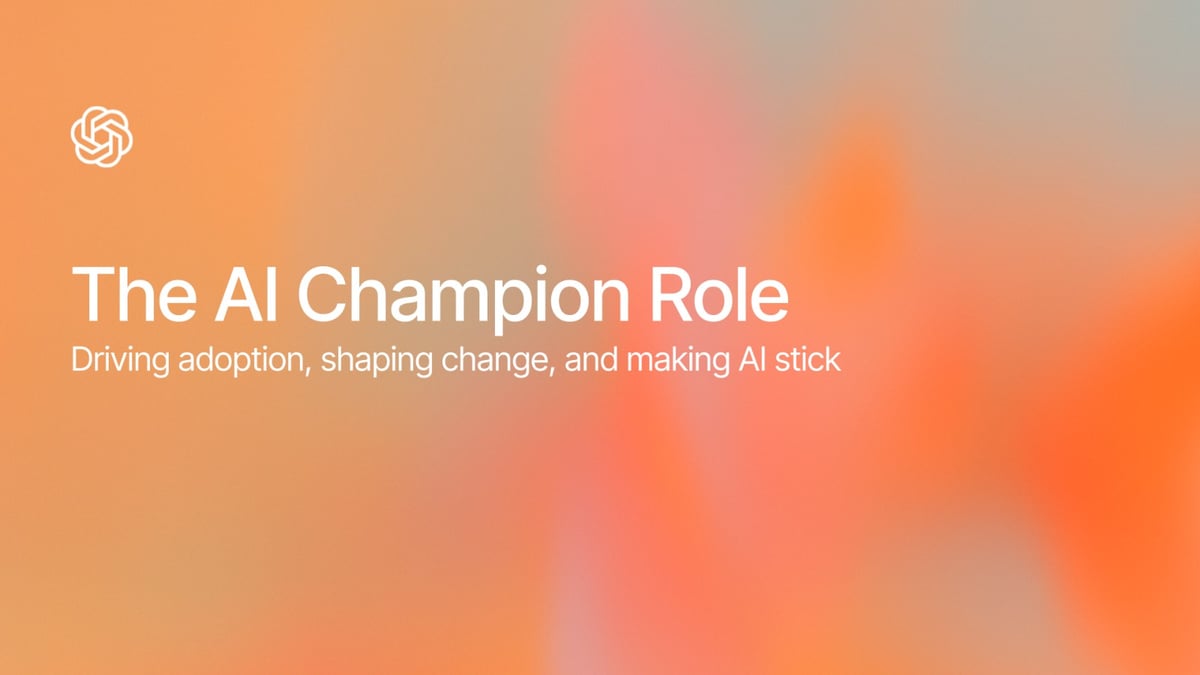The AI Champion role
AI transformation doesn’t happen because a tool is available, it happens when behavior changes. That shift requires credibility, context, and consistent examples from people inside the work.
AI Champions drive that shift.
They influence how teams adopt and apply AI by surfacing repeatable patterns, removing friction, and aligning usage with team priorities. They’re not pushing features, they’re making new ways of working visible, usable, and worth adopting.
What AI Champions do
AI Champions are embedded operators who accelerate transformation by:
- Making AI visible in high-leverage workflows
- Helping others adopt AI through real examples, going beyond general guidance
- Connecting usage to metrics the team already tracks like speed, quality, insight, consistency
- Establishing team norms around experimentation, safe use, and reuse
Champions don’t need to be the most technical person in the room. What matters is how well they translate potential into practice, starting with their own work, then extending that influence outward.
Why this role exists
Most AI rollouts stall not because of lack of access, but lack of clarity.
Champions close that gap. They:
- Build fluency by showing what’s possible and how to get there
- Reinforce quality by making better prompting and smarter workflows easier to adopt
- Establish confidence by modeling responsible, team-aligned use
- Help teams move from isolated use to consistent, repeatable value
In short: Champions don’t teach people how to use a tool, they shape how a team uses AI to work better.
What effective Champions do differently
High-trust Champions act like internal consultants: they notice what’s happening, test what’s possible, and bring others along. They focus on real constraints, not ideal scenarios.
| |
| Shares examples that solve for the team’s actual goals |
| Spots where AI is adding value—or identifies opportunities |
| Prioritizes clarity over novelty; simplifies adoption |
| Becomes the person others tag when the stakes are high |
What Champions influence
Champions aren’t just helping people try something new, they’re shaping how AI becomes embedded in how the team operates. Their influence shows up across five dimensions:
- Adoption: Usage grows not through promotion, but because someone showed what good looks like. Champions make those first few high-signal examples visible and usable
- Workflow design: Champions surface where AI can reduce friction, increase speed, or improve quality. Over time, these examples evolve into team standards
- Team norms: Champions define the tone of when to use AI, how to evaluate outputs, how to balance automation with judgment. They normalize experimentation and set expectations
- Signal routing: Champions become the layer between usage and strategy. They surface friction, share reuse patterns, and highlight what’s working at the edges
- Quality of output: The best Champions improve not just adoption, but outcomes like more consistent drafts, sharper briefs, better onboarding docs, faster synthesis
How Champions influence
Champions don’t create change by telling people to use AI. They influence how teams work by making AI easier to see, try, and trust through consistent, grounded actions.
- Show AI solving real work: Share a prompt or workflow that delivers a clear result like saving time on a recurring task, so the value of AI is obvious from the start
- Bridge the gap from concept to action: Add just enough context like why the prompt works, how to tweak it, so teammates can confidently try it themselves
- Translate AI into familiar terms: Frame examples using team workflows or metrics they already know, making AI feel like an upgrade to what they do rather than something foreign
- Keep successful AI uses visible: When a workflow lands, surface it again in team meetings or chats, showing that AI success is repeatable
- Turn one success into many: Curate the best prompts and patterns so others can adapt them without starting from scratch
- Make first tries effortless: Share examples that are pre-tested and nearly ready to run, lowering the risk of a frustrating first experience with AI
- Evolve based on feedback: Watch which prompts or workflows people keep using, and refine your next share to build on what’s sticking
Signals you’re driving change
- Someone reuses your prompt or workflow without you prompting them
- A teammate references your example in a meeting or doc
- You start getting pulled into working sessions or Slack threads
- People default to ChatGPT in the workflows you’ve touched
- You’re seeing less “What can I use AI for?” and more “Here’s how I used it”
Final thought
AI Champions don’t just help others adopt new tools, they take action to shape how teams evolve their ways of working.
They shift AI from something people try to something teams trust. They reduce friction, set new norms, and make better work easier to repeat.
Their influence shows up in the habits that stick, the workflows that scale, and the questions people stop needing to ask.
That’s how transformation becomes durable. And that’s the value of an AI Champion.



